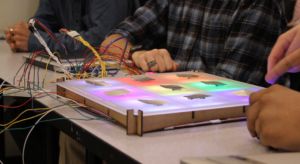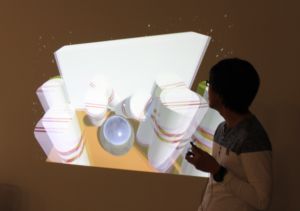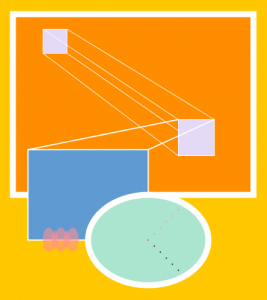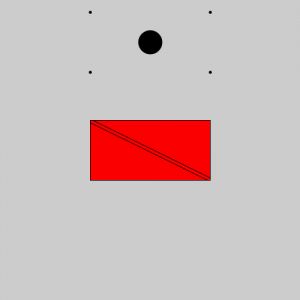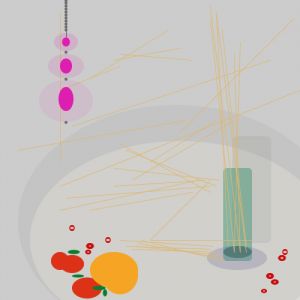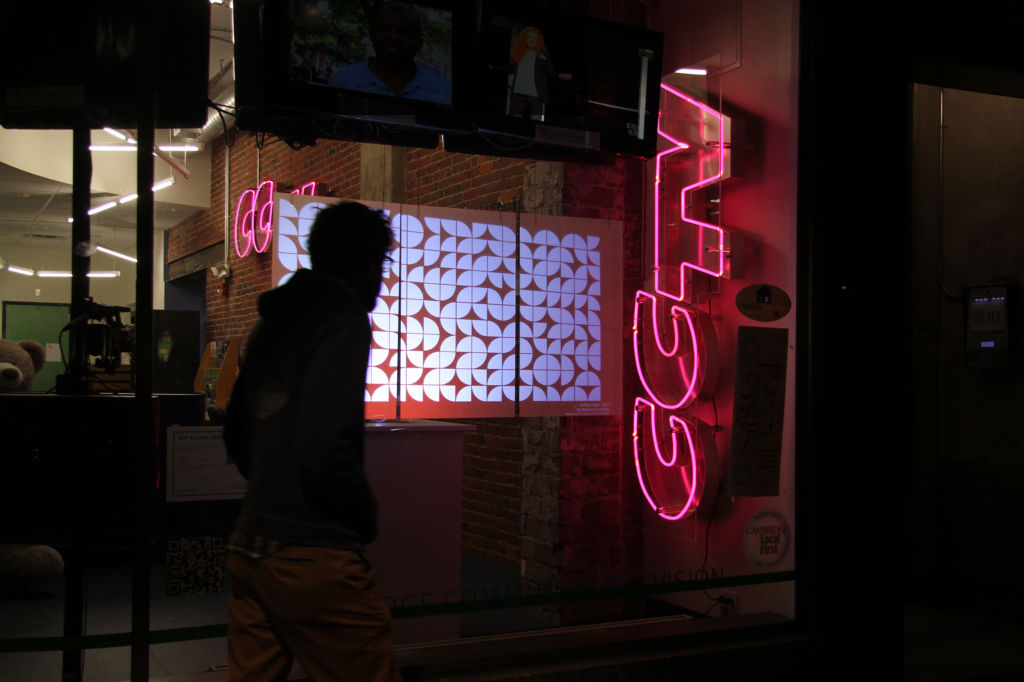
![]()
I am teaching students how to program interactive art in a new series of free workshops called Art Screen Workshop. Continue reading
Education
Teaching, talks and other education related announcements.
Collaborative Design and Creative Expression with Arduino Microcontrollers (MIT IAP 2017)
Detailed course resources available at MIT Open Courseware.
I co-led a workshop about designing, building, and prototyping electronics devices and experiences during MIT’s IAP with Kyle Keane, Mark Vrablic and Abhinav Gandhi. No previous experience with programming or electronics was required. Topics covered included micro-controller programming using Arduino, collaborative software development using GitHub, solder-less electronics prototyping, electronic sensors, rapid prototyping, and small team management. Sponsored by MIT-SUTD Collaboration, Materials Science and Engineering and Craig Carter, Professor, Materials Science and Engineering.
Long Projects
Short Projects
Description
9-day hands-on workshop about collaboration, design, and electronics prototyping. No previous experience with computer programming or electronics is required. Beginning students will be taught everything they need to know and advanced students will be challenged to learn new skills. Participants will work in small teams to design and build electronics projects using open-source microprocessors. Team projects are completely open-ended and designed by participants, past projects have included: an internet-connected weather simulation station, a giant LED billboard, and a CNC drawing machine. Participants will complete three guided projects in order to learn the fundamentals and will then break into small teams to complete a one-day mini-project of their choosing. After the mini-project, participants will break into new teams that will each get $250 and four days to design, plan, and build a custom project of their choice. On the last day of the course, students will present their projects in public exhibition and have the chance to win a prize for crowd favorite. Participants will learn about microcontroller programming using Arduino, collaborative software development using GitHub, solderless electronics prototyping, electronic sensors, rapid prototyping, and small team management.
Learn to Build Your Own Video-game with the Unity Game Engine and Microsoft Kinect (MIT IAP 2017)
Detailed course resources available at MIT Open Courseware.
I co-led a workshop about designing, building, and publishing simple educational video-games during MIT’s IAP with Kyle Keane, Mark Vrablic and Abhinav Gandhi. No previous experience with computer programming or video-game design was required. Topics covered included collaboration, video game design, Unity programming, gesture handling using the Microsoft Kinect, 3D digital object creation and small team management. Sponsored by MIT-SUTD Collaboration, Materials Science and Engineering and Craig Carter, Professor, Materials Science and Engineering.
Long Project Videos
Description
9-day hands-on workshop about designing, building, and publishing simple educational video-games. No previous experience with computer programming or video-game design is required. Beginning students will be taught everything they need to know, and advanced students will be challenged to learn new skills. Participants will work in small teams to design, build, and publish video-games that will be shared in a large public exhibition. Team projects are open-ended and designed by participants. Examples include: a collection of bouncing balls that can be sped up or slowed down using hand gestures, a virtual reality laboratory where kids can perform experiments, and crowdsourcing interface for describing scientific graphics for blind students. Participants will complete guided projects in order to learn the fundamentals and will then break into small teams to complete a one-day mini-project of their choosing. Participants will then break into new teams that will have four days to design, plan, and build a custom project of their choice. On the last day, students will present their projects in a public exhibition and have the chance to win a prize for “crowd favorite”. Participants will learn about video-game creation using the Unity game engine, collaborative software development using GitHub, gesture handling using the Microsoft Kinect, 3D digital object creation, video-game design, and small team management.
Artist Talk: The Art of Composition or: How I Learned To Stop Programming and Love the UNIX Pipe
I gave an artist talk titled “The Art of Composition or: How I Learned To Stop Programming and Love the UNIX Pipe” on Thursday October 27, 2016 for the MassArt Professional and Continuing Education Thursday Night Lecture Series. I weaved together a short explanation and demonstration of UNIX pipes together with programming, art, composition and my artistic practice.
Artist Talk (Work, Inspiration, Code & Scratch) —2016
I gave an artist talk about my work, inspirations and programming for Sejal Patel’s Teaching in New Media course. This was followed by a brief introduction and workshop on the Scratch programming language.
Slides from the talk: Artist Talk Slides (13mb PDF).
Additional Resources
- ScratchEd a Harvard run resource for Scratch educations. They also produce a PDF Scratch Curriculum Guide for educators and learners.
- ScratchJR a tablet based Scratch language designed for slightly younger programmers.
- Channel 5 Special on Seymour Papert at MIT CSAIL. Six minute video from 1972 of Seymour Papert describing his LOGO programming language.
- Mitchel Resnick 2011 McGraw Prize in Education Acceptance Speech. Mitch Resnick acceptance speech, excellent short summary of his personal philosophies of education that drove the design of Scratch.
Sejal Patel’s Teaching in New Media Course Description
This course covers issues of teaching art in new media through project-based inquiry. Students evaluate the roles of multiple media and technology for existing art curriculum and develop projects that support the physical art making experience. Most classes will be structured as a combination of lectures, conversations, visits to maker labs, research and studio time. The final project for the class will be the development of an interdisciplinary unit or curriculum with supporting materials.
Collaborative Design With Arduino (MIT IAP 2016)

I co-led an 8 day workshop during MIT’s IAP 2016 called “Collaborative Design with Arduino” along with Kyle Keane and Mark Vrablic. Continue reading
Coding Dynamic Experiences
Learn how to articulate and communicate your ideas through the medium of software code. Topics include culture & technology, social networks, design as social practice, and data visualization.
I developed the course Coding Dynamic Experiences for the MassArt Continuing Education department in the Summer of 2015. The course is designed to teach the fundamentals of programming in the context of designed interactive experiences. Course website summer 2015.
Student Work Samples (Summer 2015)
Teaching “Coding Dynamic Experiences” June 2015
I will be teaching “Coding Dynamic Experiences” through the MassArt Continuing Education department this Summer 2015. Tuesdays and Thursdays from 6—9pm running June 2nd through July 9th 2015. Continue reading
Teaching “Introduction to Web Design” Jan 2015
I will be teaching “Introduction to Web Design” through the MassArt Continuing Education department this Spring 2015. Continue reading
How Different Software Languages & Libraries Affect Your Creative Process
Slides with presenter notes from the talk
Code and Creativity talk MIT IAP (pdf ~16mb)
At the end of the talk I live coded in Processing, here is an animated gif of the result

Continue reading
